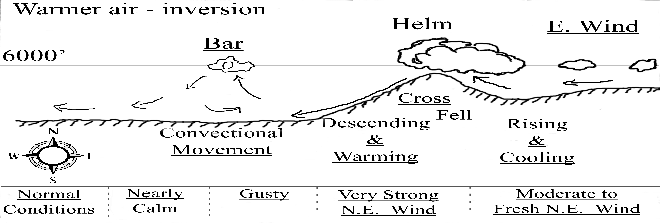
Dufton Pike and the Helm Bar
This is one of the best examples in Britain of a local wind - one caused by a particular combination of circumstances in a specific area.
The word 'helm' means hilltop, and the Helm is a fierce easterly wind which can last for days on end blowing along the Fellside. It is most strongly felt at Milburn, but is also noticeable all the way from Brough to Brampton (near Carlisle).
It is caused by air from the east ascending the slopes of the Pennines in the vicinity of Cross Fell. As the air rises, it is cooled (Cross Fell is the highest point of the Pennines). A cloud 'cap' - the helm - is formed along the top of the Pennines near Cross Fell. The air now literally rushes down the west4acing slopes becoming warmer as it does so. It also meets warmer air from the west. Warm air rises but another particular circumstance of the Helm is that there is frequently a temperature inversion at about 6,000 feet. Usually as you rise through the atmosphere, temperatures drop at a steady rate for quite some distance, but in the case of an inversion1 a layer of warm air is found at height instead of cold. The warm air has been cooled as it rose to 6,000 feet. It has become heavier and the moisture in it condenses to form clouds. From the ground, these clouds take the shape of what is called the 'Helm Bar' - a line of cloud some distance from the cap of cloud on the Pennine tops. The gap between the summit cap and the Bar represent the descending air and will vary according to local temperature and pressure conditions. Within the Bar, air is moving turbulently as convection currents operate. Warm air has risen from the ground, has cooled, become denser and sunk to the ground. Here it is warmed again, begins to rise and so the circular motion continues. The Helm ends when the direction of the wind changes from easterly.
